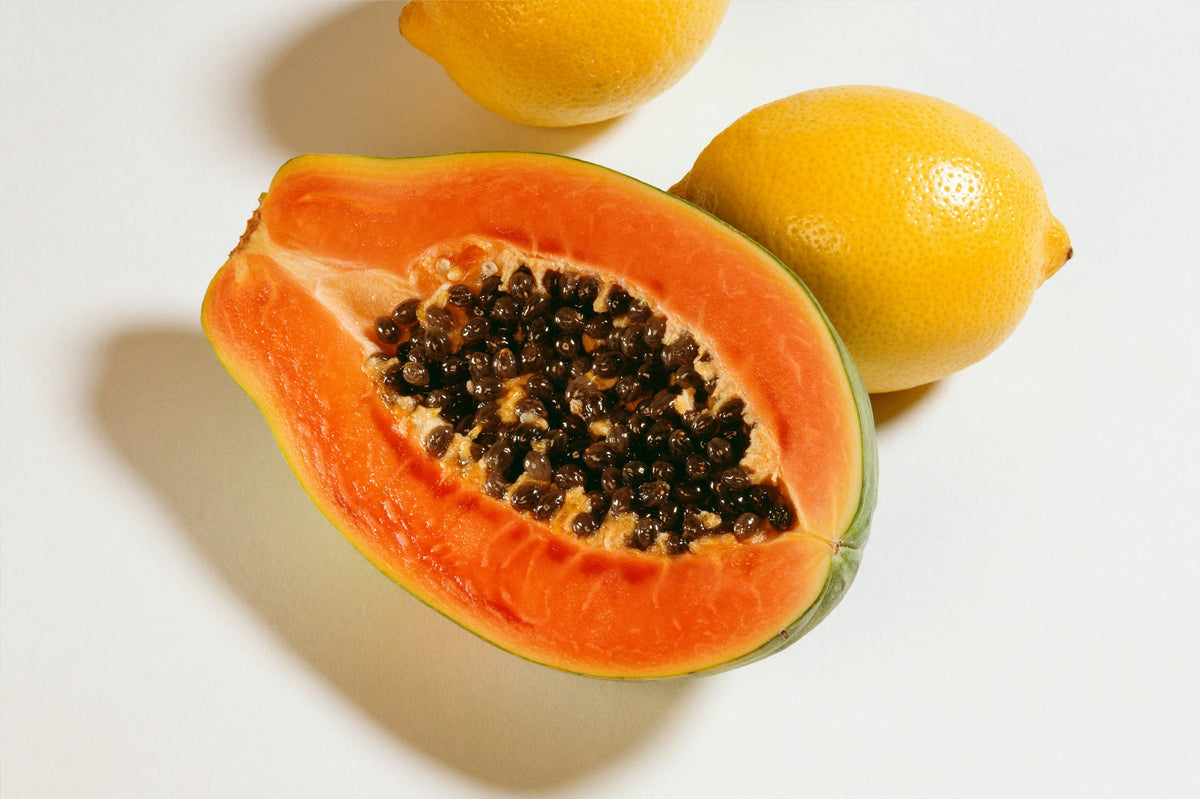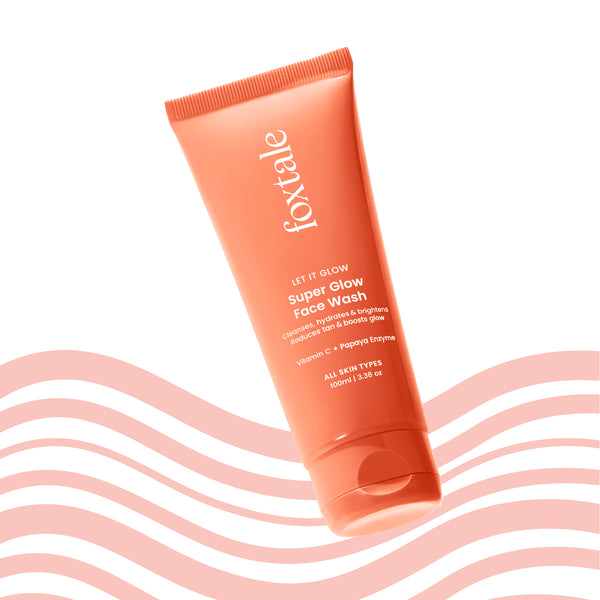
Papaya isn’t usually the first ingredient that pops up while discussing skincare—yet it arguably deserves more attention. Often dismissed as just another tropical fruit, papaya carries a quiet but powerful range of compounds that directly affect the skin’s surface and functionalities.
This includes papain, a natural enzyme that breaks down proteins. Not just in food digestion—on the skin, it works to dissolve dead cells. Alongside this, papaya delivers antioxidant Vitamins like C and A, flavonoids, lycopene, and trace minerals that contribute to improved skin clarity, smoother tone, and stronger resilience.
What sets it apart is the way it works: gradual, non-abrasive, and deeply compatible with sensitive or reactive skin types. Whether used in a clinical formulation or mashed into a DIY blend, papaya offers benefits that stretch across exfoliation, pigmentation, hydration, and even barrier health.
Exfoliates Dead Skin Cells – Papaya Enzyme Benefits for Gentle Renewal
Grainy scrubs often damage the skin’s outer layer. Acids, while effective, can cause redness or sensitivity in rare cases. Papaya functions differently.
Its enzyme, papain,breaks down the keratin proteins that hold dead skin cells together. As a result, dull or rough texture lifts away without disrupting the moisture barrier.
This method is particularly well-suited to skin types that can’t tolerate acids or microbeads. Where Glycolic Acid might cause flare-ups papaya operates quietly – a low-risk entry point into exfoliation. Especially beneficial for those skin.with sensitive skin.
There are many benefits of papaya enzyme. Products containing papaya enzyme, like gentle foaming cleansers or low-concentration enzyme masks, can be used a few times a week without causing imbalance. One example is the Papaya Face Wash, which includes a stabilized form of papaya extract.
Fades Dark Spots and Pigmentation – A Key Papaya Benefit for Skin
Hyperpigmentation has many triggers—sun exposure, hormonal triggers, post-acne healing. Once discoloration sets in, reversing it can be difficult. Papaya takes a two-fold approach to this problem
First, papain promotes the removal of dead and pigmented cells from the surface. Second, papaya’s Vitamin C content works to regulate melanin production, which helps reduce further discoloration. This dual mechanism makes it ideal for gradually improving skin tone without irritating or sensitizing the area.
Brightening isn’t instantaneous. But over time, consistent use of papaya-based products may encourage clearer tone and a reduction in visible spots—especially when combined with SPF and melanin-regulating ingredients like Niacinamide.
Controls Acne and Breakouts – One of the Lesser-Known Papaya Benefits
Papaya’s role in managing acne is not as widely recognized, but it holds value—particularly in cases of mild congestion or hormonal imbalance.
The exfoliating action of papain clears pore-clogging debris, while its natural antibacterial and anti-inflammatory properties reduce breakouts. It doesn’t attack breakouts aggressively. Instead, it diffuses them before they fully form.
Hydrates and Nourishes the Skin – Deep Moisture from Papaya Fruit
Every skin type—including oily and acne-prone—requires consistent hydration to function properly. Papaya contributes here, though not in the way a heavy cream might.
It contains natural sugars and water-soluble nutrients that act as humectants. These draw water into the skin. Simultaneously, Vitamins A and E improve the skin’s capacity to retain moisture and prevent trans-epidermal water loss (TEWL).
Reduces Signs of Aging – Anti-Aging Papaya Benefits for Skin
The visible signs of skin aging—fine lines, uneven tone, rough texture—result from a complex mix of inflammation, collagen loss, oxidative stress, and external exposure. Papaya offers a few subtle yet meaningful tools to address these factors.
Lycopene, a powerful antioxidant present in papaya, protects against free radical damage. This reduces the breakdown of collagen and elastin. Vitamin C supports natural repair mechanisms, while papain smooths the skin’s surface, making light reflect more evenly and texture appear refined.
Soothes Sunburn and Skin Irritation – Cooling Benefit of Papaya Fruit
Papaya’s anti-inflammatory enzymes help calm irritated skin, especially after sun exposure or minor barrier disruption. Combined with its hydrating base, papaya functions as a natural post-stress recovery ingredient.
In cases of sunburn, enzyme-based topicals reduce the buildup of damaged proteins on the skin’s surface, which can speed up repair. The water content provides immediate relief, and Vitamin E adds a layer of antioxidant protection to avoid further cellular stress.
How to Use Papaya for Skin: Tips for Maximum Benefits
Papaya-based skincare can be introduced in multiple formats, depending on skin goals and tolerance levels.
For new users, enzyme cleansers or papaya-infused face washes offer a mild way to explore its benefits. These products typically combine papaya extract with surfactants and hydrating agents, providing light exfoliation during cleansing. Foxtale’s Super Glow Face Wash is one example that includes this balance.
For those preferring DIY, ripe papaya can be blended with honey, aloe vera, or yogurt to create a hydrating, soothing mask. These treatments should be kept under 20 minutes and rinsed with cool water. Always patch-test.
No matter the method, papaya treatments should always be followed with a moisturizer—and daytime application should be paired with sunscreen. Skin exposed to exfoliants, even gentle ones, becomes more susceptible to UV damage.
Final Thoughts on the Skin Benefits of Papaya
Papaya doesn’t act quickly. It doesn’t promise high-impact change in two days. But its effects accumulate—with subtlety and consistency.
As an ingredient, it sits comfortably between performance and gentleness. It works across skin types, across concerns, and doesn’t demand complex routines or strict layering.
Ideal for minimalists. Useful for ingredient-sensitive users. Complementary to active-heavy routines.
FAQs
Can papaya be used daily on the face?
It depends on the formulation. Papaya-based cleansers may be used daily, while enzyme masks or peels should be limited to 1–3 times per week depending on skin sensitivity.
Is papaya safe for sensitive skin?
Generally, yes. Papain is gentler than most exfoliating acids, but patch testing is always recommended—especially if the skin is reactive or compromised.
What skin types benefit most from papaya enzyme treatments?
Normal, oily, combination, and acne-prone skin types may see the most visible benefit. Dry and mature skin types can also benefit, provided the papaya formula includes hydrating components to prevent moisture loss.




